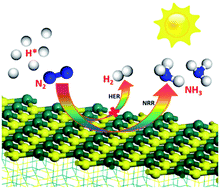Nitrogen fixation on metal-free SiC(111) polar surfaces†
Abstract
The boron atom as an electron “acceptor–donor” center that induces nitrogen fixation has recently been reported in both molecular (M.-A. Légaré, G. Bélanger-Chabot, R. D. Dewhurst, E. Welz, I. Krummenacher, B. Engels and H. Braunschweig, Science, 2018, 359, 896–900) and heterogeneous (C. Ling, X. Niu, Q. Li, A. Du and J. Wang, J. Am. Chem. Soc., 2018, 140, 14161–14168 & C. Liu, Q. Li, C. Wu, J. Zhang, Y. Jin, D. R. MacFarlane and C. Sun, J. Am. Chem. Soc., 2019, 141, 2884–2888) catalysis. In this work, we report alternative economic metal-free SiC as an excellent nitrogen fixation catalyst. Surface Si and C on SiC(111) behave similarly to the boron atom, with the strong bonding and activation of N2, and the effective reduction of N2 to NH3 on the Si-terminated surface has a low limiting potential (−0.54 V). More importantly, the adsorbed N2 can be efficiently reduced to NH3 on C-terminated SiC(111) with a rather low limiting potential (−0.22 V) via an enzymatic pathway and the hydrogen evolution reaction can be significantly inhibited, indicating its excellent selectivity and efficiency. Overall, our study provides insights into nitrogen fixation on SiC and, more importantly, extends a series of catalysts beyond boron for converting nitrogen into more valuable NH3 on abundant metal-free catalysts.



 Please wait while we load your content...
Please wait while we load your content...